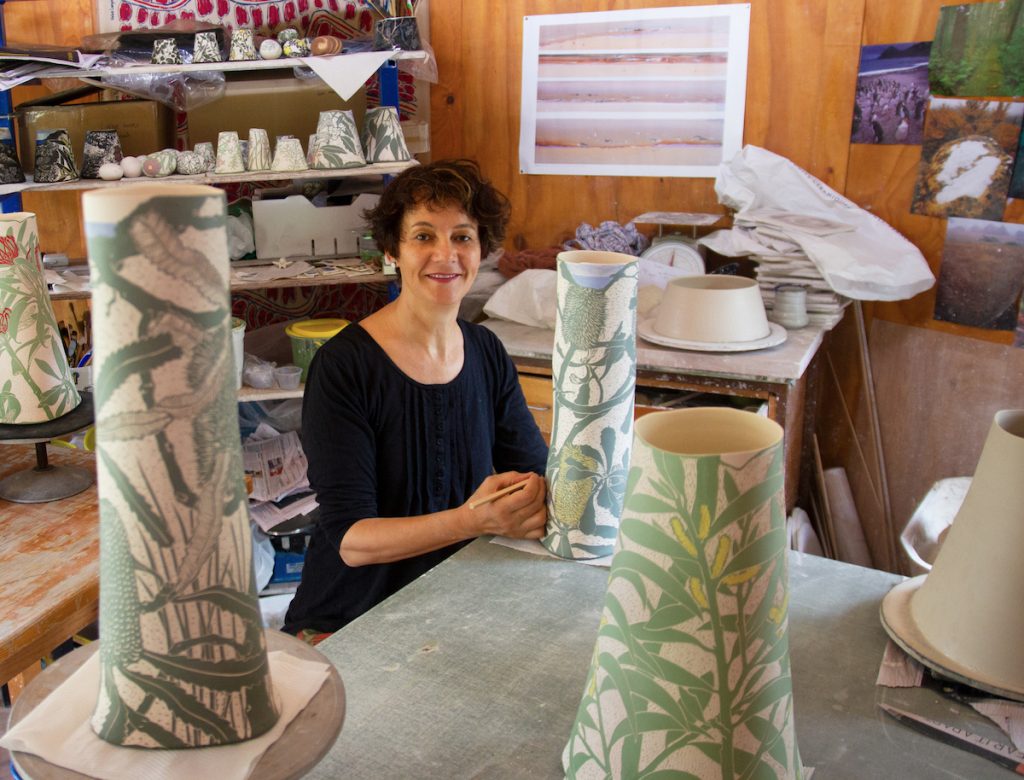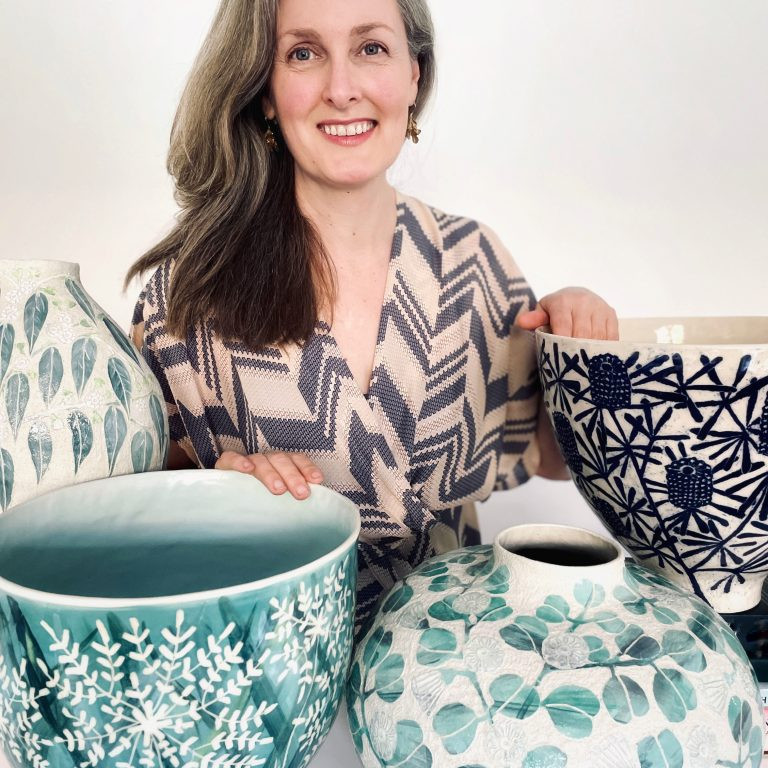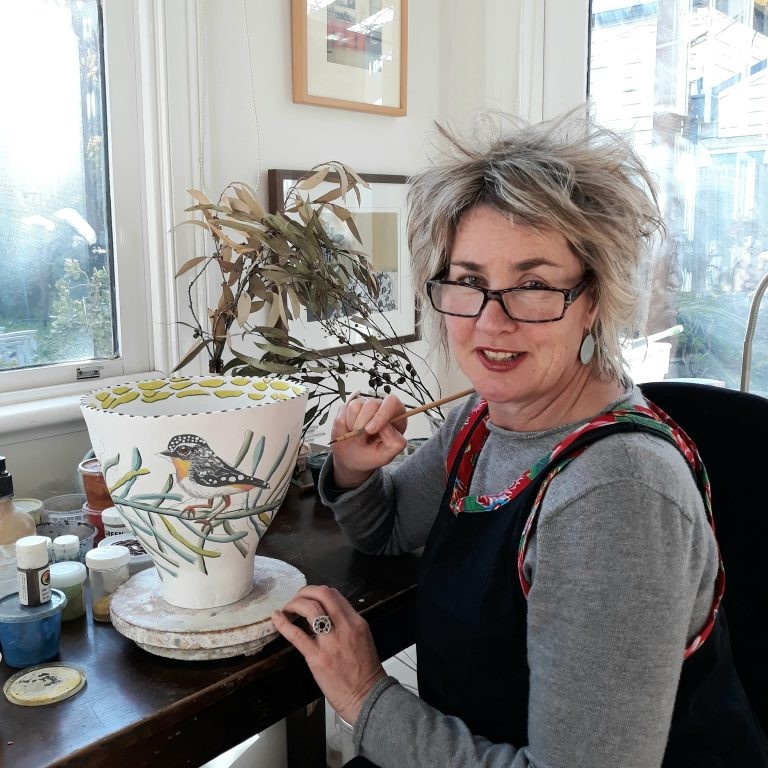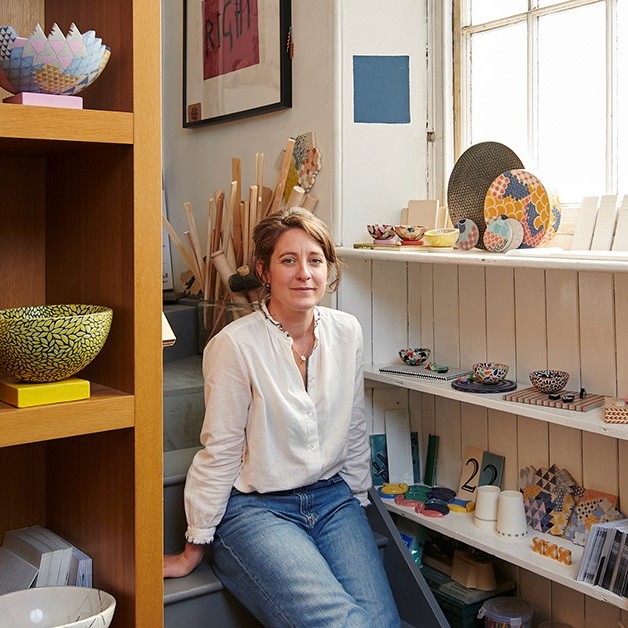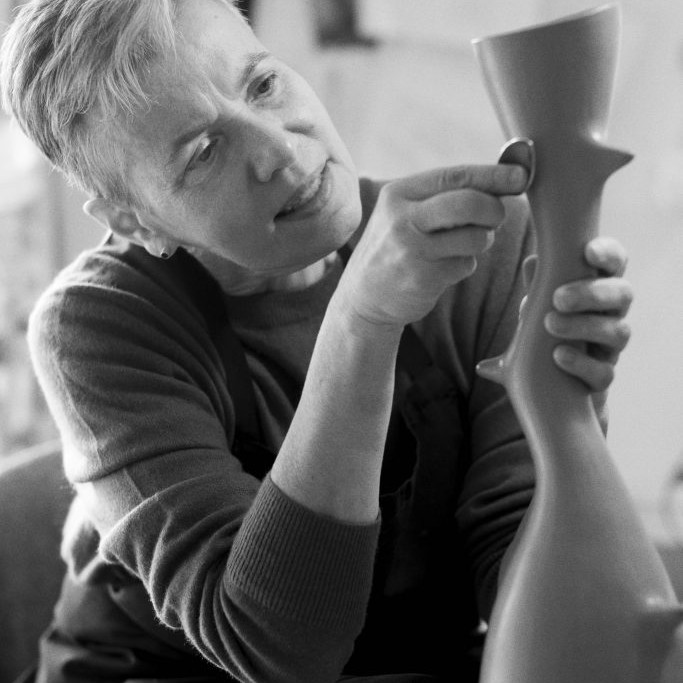Cathy Franzi Ceramic Artist
Can you discuss how the Nelson Nichols Scholarship has affected your art practice?
I received this award in my first year of a Master of Visual Arts (Ceramics) at the Australian National University School of Art & Design. The scholarship was a generous donation from Gail Nichols and David Nelson supporting early career ceramic students. The scholarship gave me confidence in the direction my work was taking at the end of my first year at Art School, having already worked in the ceramics field for 15 years.
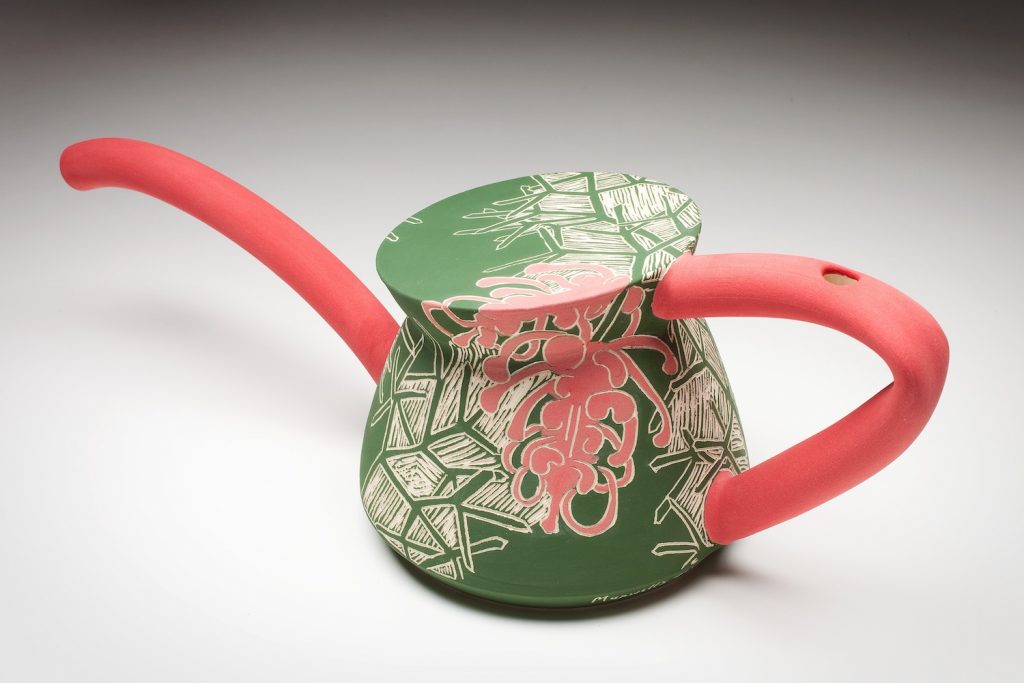
Maxwells Grevillea, From Endangered Series, 2010. Mid-Fired Clay,
wheel-thrown and altered, sgraffito, 16h x 32w cm. Photo by Stuart Hay
Where did the botanical interests come from?
I have always been fascinated in plants and was fortunate to have a childhood filled with camping holidays and bushwalks. My immersion in the Australian bush and my subsequent love of nature motivates my deep botanical and environmental interest. I followed this path through my first degree in science before I began a career in ceramic visual art.
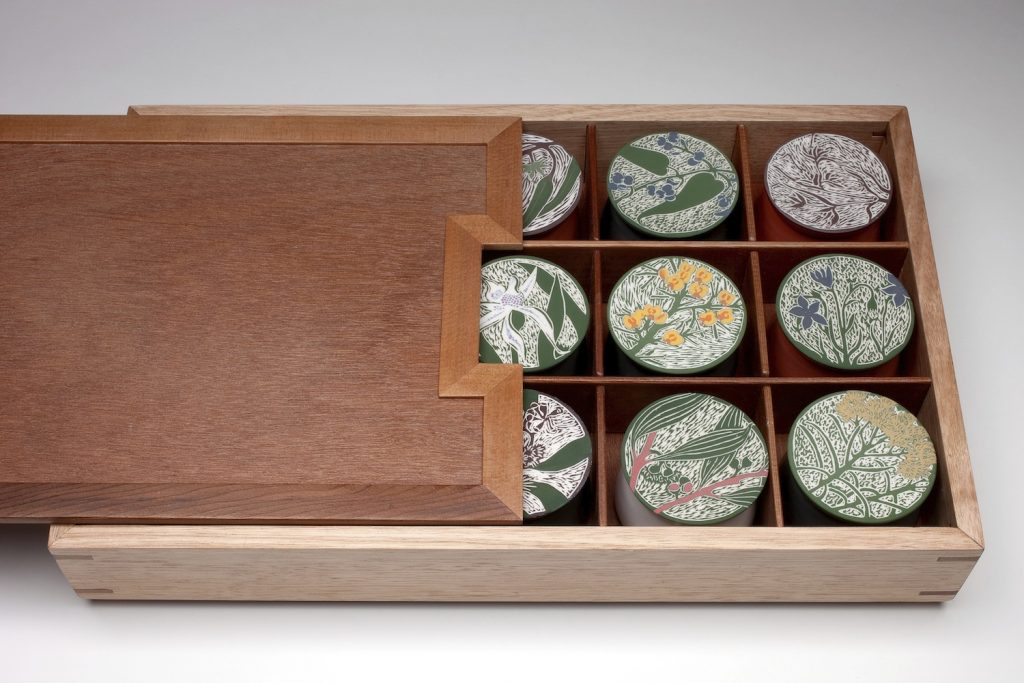
Mt Majura Seed Box, 2010, Porcelain, wheel-thrown, sgraffito,
recycled timber, 6h x 40w x 15d cm, Photo by Stuart Hay
How has your work given a new voice to Australian flora?
Currently there is a renewed interest in Australian flora in art and design, in part because of the extraordinary shapes and textures to be found, and perhaps because of increased awareness of our poor environmental health and lack of action. This is certainly from where my voice and activism lie.

Natural Temperate Grasslands, 2015, Porcelain, stoneware wheel-thrown, sgraffito, and inlay, 37h x 40w x 16d cm, Photo by Rob Little, Digital image
How have your travels working in ceramics in Ireland, UK and NZ influenced your need to develop your own Australian style?
My experience working overseas and immersion in the history of ceramics through visiting the great museums and galleries of the world has deepened my appreciation of the way ceramics captures the materials, technology and culture of a place, time and people. This is what I aim to do in my own work.
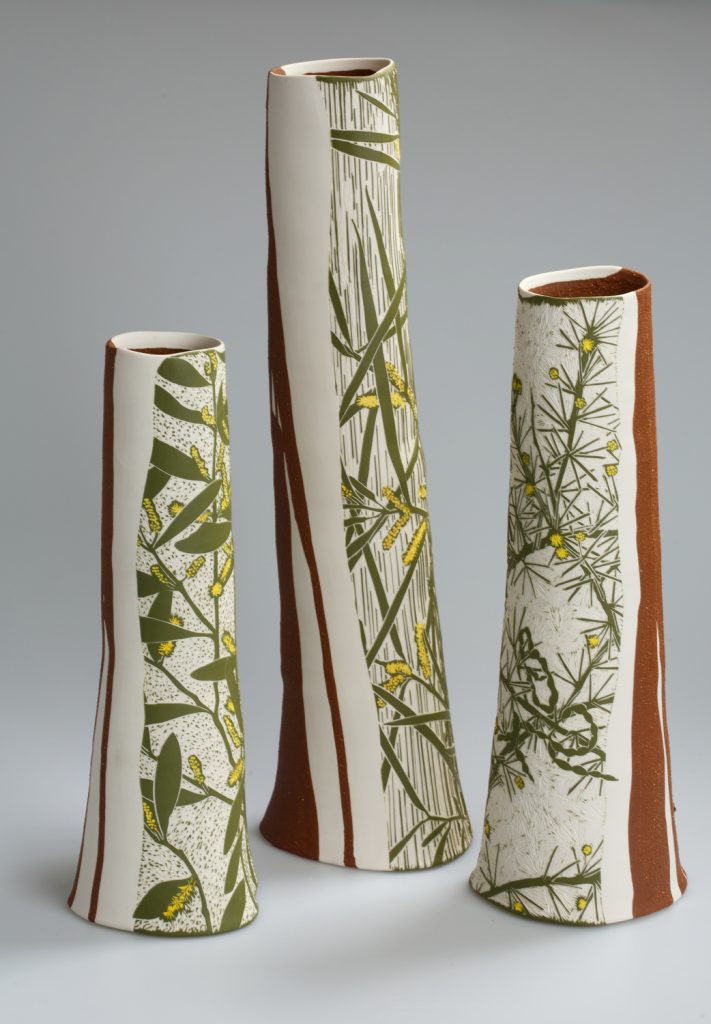
Arid-zone Acacias, 2016, Porcelain, 55.5h x 15.2w x13.3d cm,
Photo by Andrew Sikorski-Art Atelier
You have work in the Centenary Capsule in Canberra. Discuss
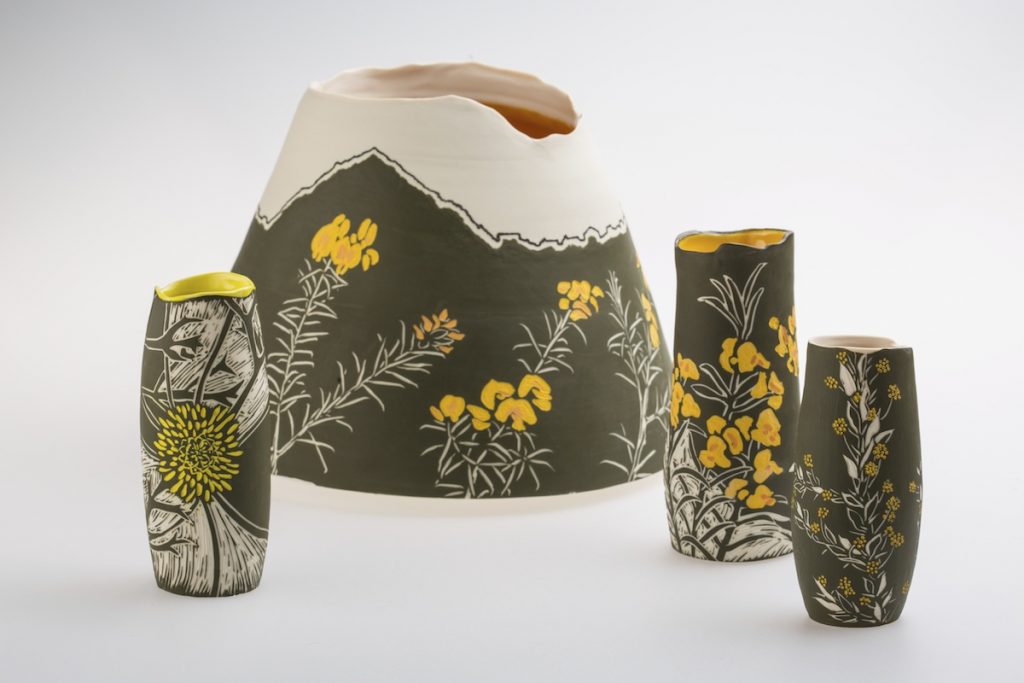
Golden Hill, Detail, 2013, Porcelain, wheel-thrown, 20h x 20w cm,
Photo by David Paterson
Canberra’s centenary in 2013 was acknowledged through a wide range of exhibitions and cultural events reflecting on its design history, architecture and landscape. During this year I created a solo exhibition based on Walter Burley Griffin and Marion Mahony Griffin’s plan to revegetate the hills of Canberra in single colour plantings of predominately flowering Australian flora. My research led me to Mahony Griffin’s colour-coded botanical notebooks held in the National Library of Australia. I followed this with research in the field to examine the species growing on each of the five sites. The exhibition ‘Painting the Hills of Canberra’ was shown at CraftACT: Craft and Design Centre and it was from this body of work, inspired by Canberra, that a small vessel decorated with a local plant was chosen to be included in the Time Capsule.
One hundred objects are in the time capsule providing a snapshot of life in Canberra in 2013 and includes all sorts of things such as artworks and photographs, letters, restaurant menus, and even a parking fine. Descriptions of the significance of each object is also sealed in the time capsule to be opened in 2113. I think it is a fascinating project and provokes our imagination to the future.
You have been awarded the Biennial North Queensland Ceramic Awards along with many others. Discuss this one in particular.
The actual award-winning piece.
The design
The actual botanical information
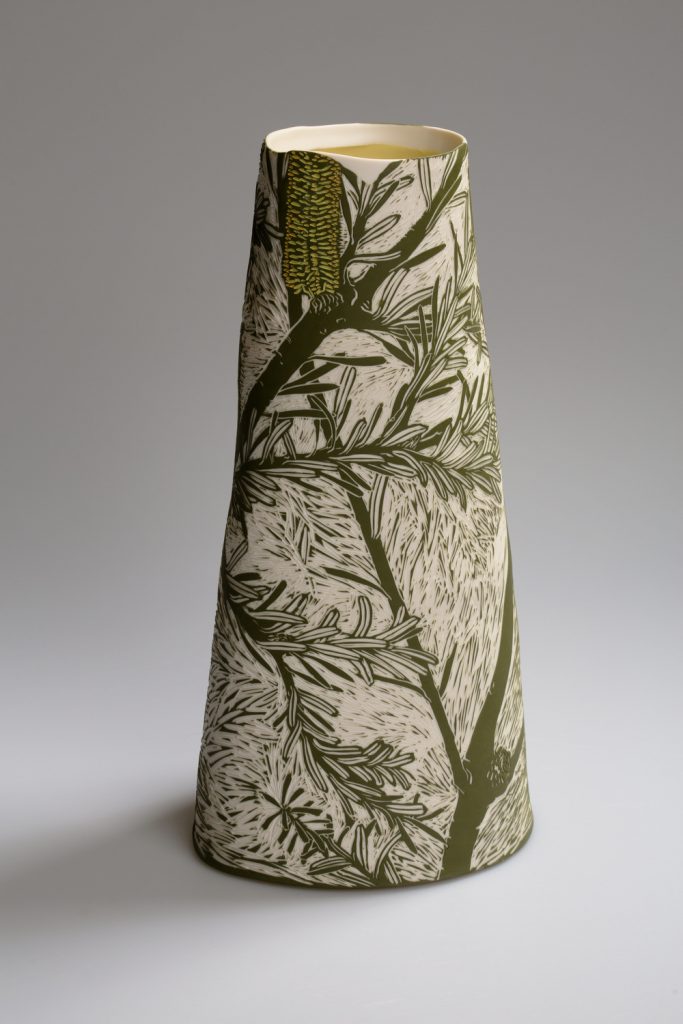
Silver Banksia, 2016, Porcelain, wheel-thrown, and altered,
38.4h x 19.5w x 11d cm,
Photo by Andrew Sikorski-Art Atelier
We are fortunate to have many competitions and awards specifically for ceramics. The Biennial North Queensland Ceramic Award has long aimed to increase public exposure to a high standard of ceramic visual art and displays the diversity of work currently being produced in Australia. I received the Scott Brickworks Acquisitive Award for the work ‘Silver Banksia’ based on the species Banksia marginata.
How do you research the plants on your vessels?
I am committed to understanding the plants I represent on my artwork. Where they grow, the ecology and environment in which they belong and the threats they face. To gain this knowledge I have developed a long-term engagement with botanical science.
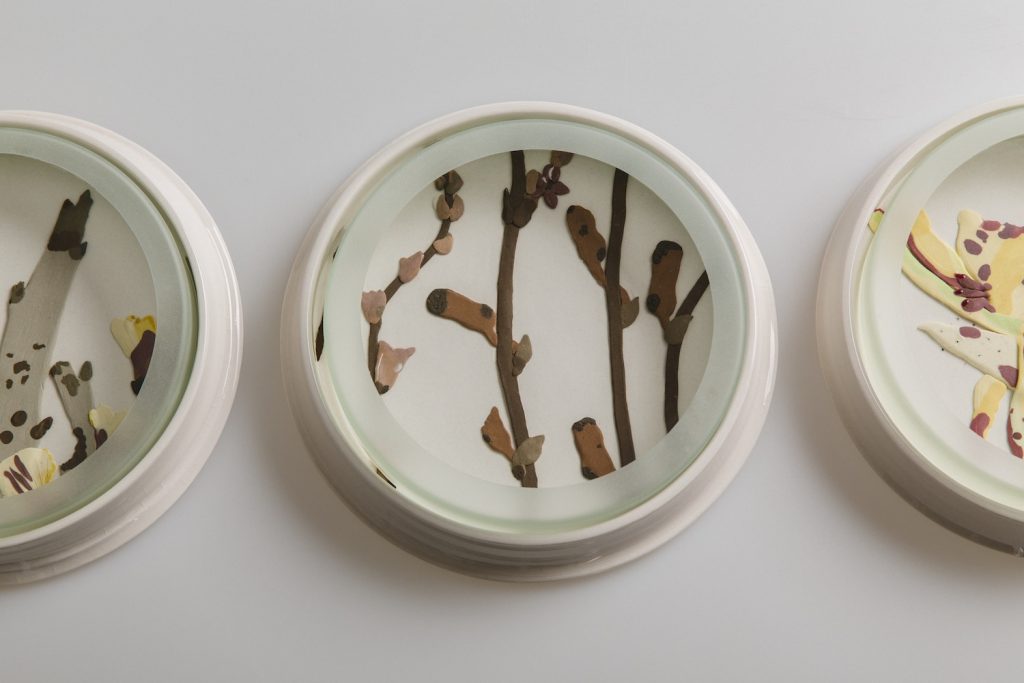
Herbarium Dishes, 7 Endangered (detail), 2015, Porcelain, etched glass,
6h x 1600w x 22d cm,
Photo by Andrew Sikorski-Art Atelier
I spend time in the field researching plants and seek opportunities to work with scientists. For example, I am a volunteer with the National Seed Bank on their seed collecting expeditions. I research plants in the Australian National Herbarium, through databases and in Living Plant collections. Many of my exhibitions are based on specific plants in specific locations where I have had an involvement with botanists.
Are there any endangered plants on any of your vessels?
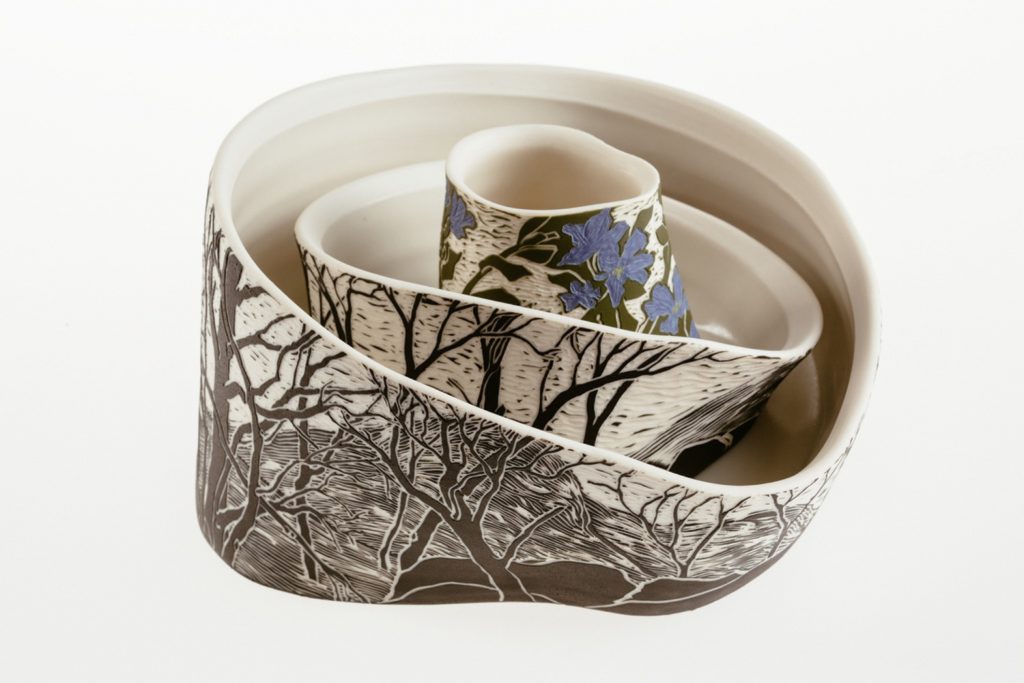
The Ephemeral Dampiera fusca: Tinderry Range, 2014, Porcelain,
16h x 28w x 14d cm,
Photo by Andrew Sikorski-Art Atelier
Unfortunately, many plants in Australia are endangered and in any ecosystem there will be plants under threat, if not the whole ecosystem. Therefore, I represent endangered plants on my work often. I am currently part of the project ‘Art of Threatened Species’ through the NSW Office of Environment & Heritage and Orana Arts. So far, I have been out in the field with Threatened Species Officers to study three endangered orchids, The Crimson Spider Orchid, The Sandhill Spider Orchid and Oaklands Diuris. My subsequent artwork will be part of a touring exhibition later in the year.
Are all the plants named on the vessel or just your mark?

Lambertia inermis, 2017, Porcelain, wheel-thrown and altered, sgraffito, 10h x 12.5w x 10.1d cm, Photo by Andrew Sikorski-Art Atelier
I sign all my work with the name of the plant.
Do you find the buyers gravitate to specific plants or is it a design response?
I think it can be both. My aim is to find a way to capture the character of the plant in design, colour, technique and ceramic materials.

Orchid Set, Set of 3 Orchids from The Canberra Flora Series, 2017, Porcelain, wheel-thrown , ink inlay, 17h x 9w x 4d cm,
Photo by Andrew Sikorski-Art Atelier
Colour of Australian native plants are very distinctive. Discuss this using 1 or 2 pieces.
The colours of plants in Australia vary widely from olive green to the silver blue of some Eucalypts. I am constantly testing my materials to find colours that capture this. Ceramic materials only show their true colour after the final firing, which makes it very tricky!
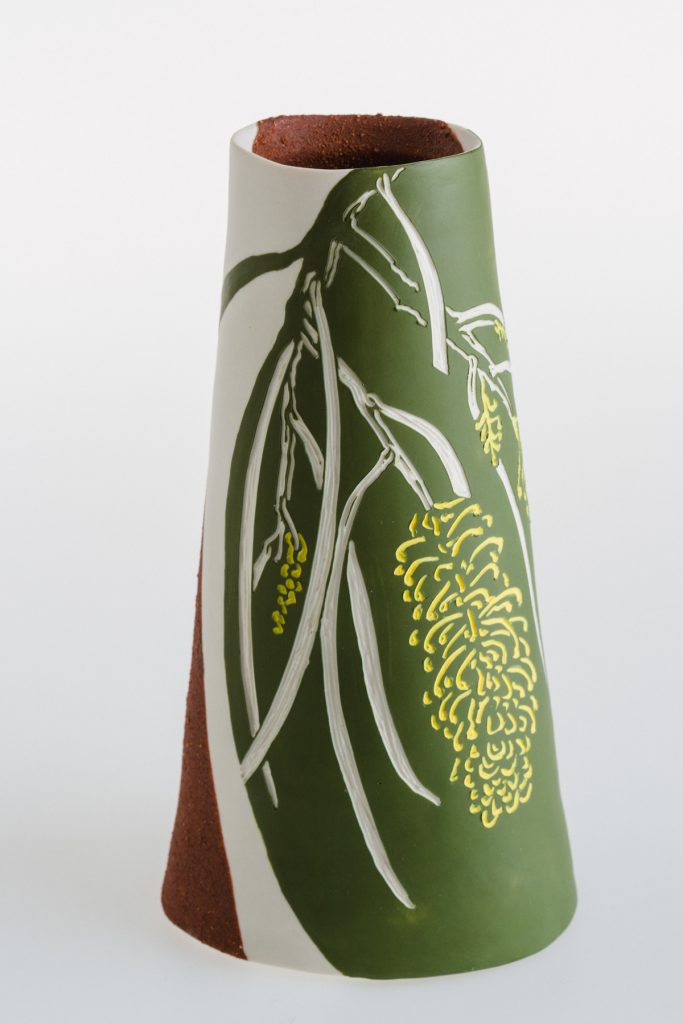 Hakea lorea, 2015, Porcelain, mid-fire slip wheel-thrown, sgraffito,
Hakea lorea, 2015, Porcelain, mid-fire slip wheel-thrown, sgraffito,
14h x 8w x 10.6d cm, Photo by Andrew Sikorski-Art Atelier
Size, what are the restriction on the size of your work?
At the moment I am restricted by the size of my largest kiln, which is 900 mm height by 600 mm width.

Saw Banksia, 2018, Porcelain, wheel-thrown and altered, sgraffito,
75.8h x 18.9w x 18.4d cm, Photo by Andrew Sikorski-Art Atelier
Take 1 or 2 pieces that you have made recently and discuss.
Design both shape and artwork
Technique (briefly)
What was it the excited you about the finished piece/s and why?
My last solo exhibition was at Sabbia Gallery in Paddington Sydney and was based on a residency I had at Fremantle Arts Centre earlier in the year. During my residency I went on a field trip with staff from the Threatened Species Seed Centre into the Stirling Range National Park in Western Australia’s biodiversity hotspot. We collected seed from the highly threatened Banksia anatona and it was this plant and 11 other extraordinary Banksias that I chose to work with for my exhibition.
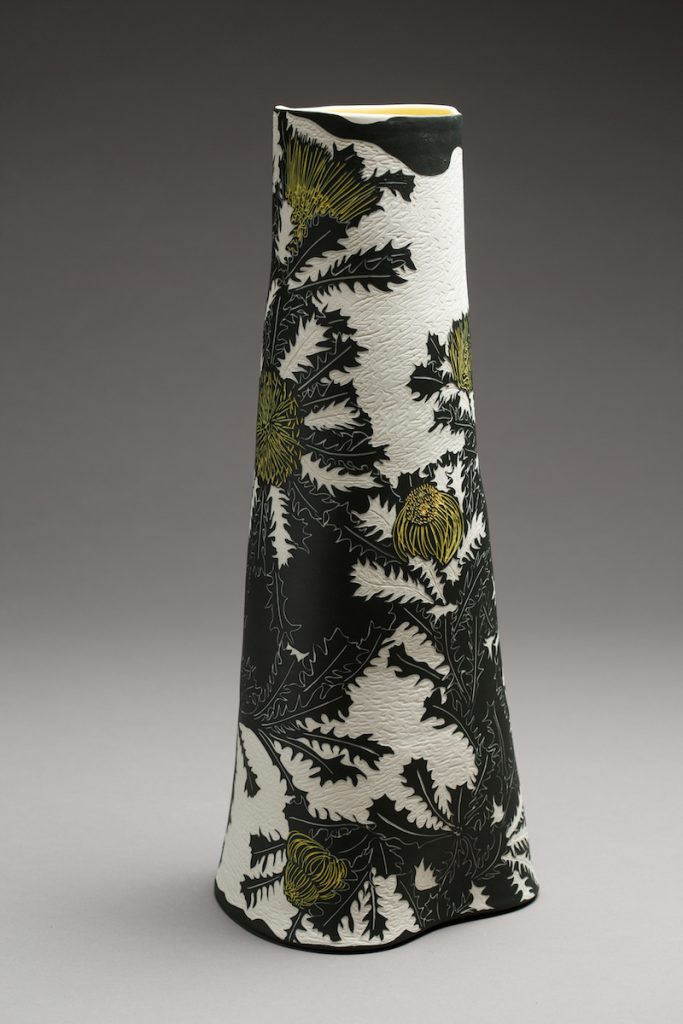
Banksia anatona, 2018, Porcelain, wheel-thrown and altered, sgraffito,
53.2h x 22w x 20.5d cm,Photo by Andrew Sikorski-Art Atelier
My vessel forms are thrown and altered on the potters’ wheel in porcelain. The technique I use is sgraffito where I carve the surface material away to ‘draw’ my design on the ceramic surface.
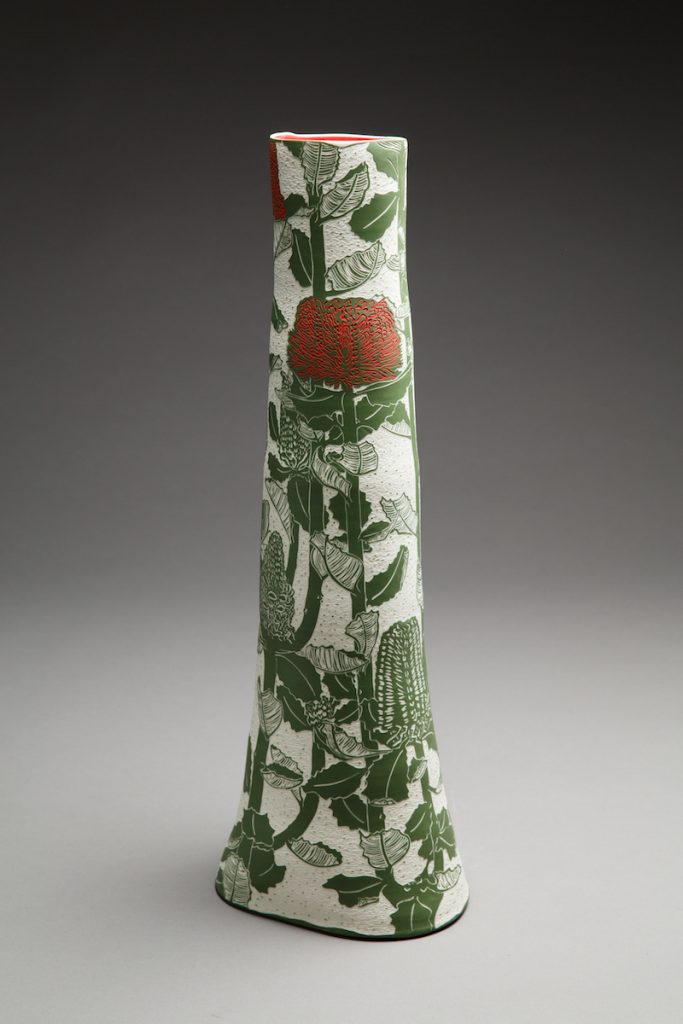
Banksia coccinea, 2018, Porcelain, wheel-thrown and altered, sgraffito,
66.4h x 23.5w x 20.5d cm,Photo by Andrew Sikorski-Art Atelier
Your work is in many collections, can you take one that has given your career a challenge?
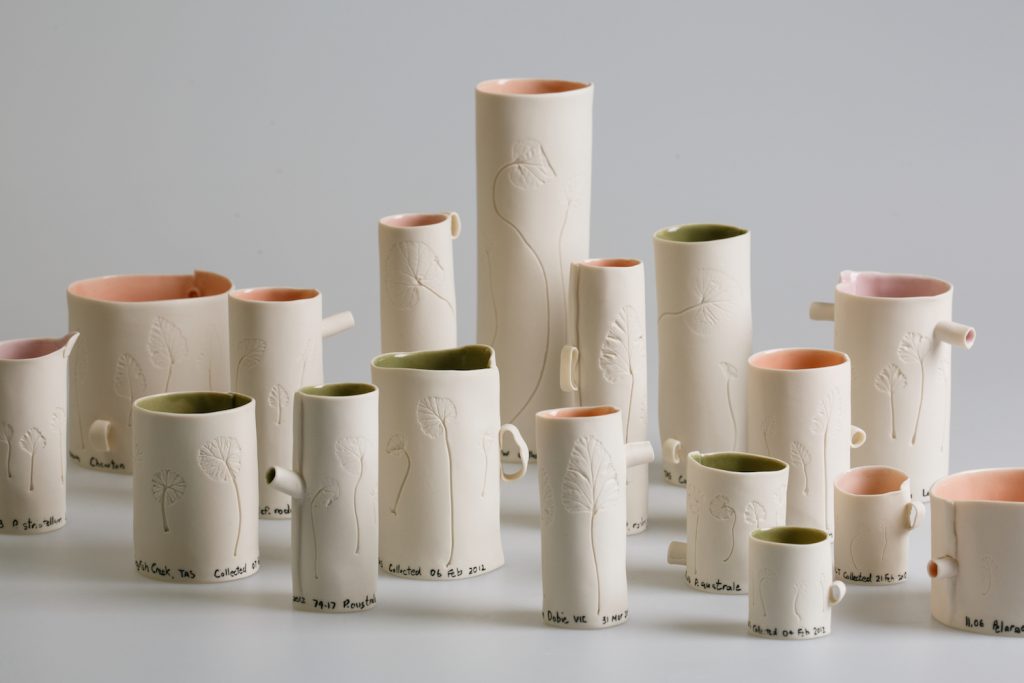
Patterns of Distribution, (In leaf shape of Australian Pelargonium species (detail) 2016, Porcelain, 16h x 108w x 36d cm,
Photo by Andrew Sikorski-Art Atelier
In 2016 I had a residency in the Australian National University Research School of Biology with Professor Adrienne Nicotra. I was awarded the residency through the prestigious Vice-Chancellor’s College Artist Fellows Scheme, as an opportunity for post-doctoral interdisciplinary research. In the Nicotra lab I engaged with their research on leaf form and function of two Australian plant species, Alpine Buttercups and Pelargoniums. My usual way of representing plants did not seem appropriate and so I experimented with new ways to be able to capture leaf shape and form with accuracy. The resulting artwork is now in the collection of the Research School of Biology.
 Patterns of Distribution (detail) (In leaf shape of Australian Pelargonium species (detail) 2016, Porcelain, 16h x 108w x 36d cm, Photo by Andrew Sikorski-Art Atelier
Patterns of Distribution (detail) (In leaf shape of Australian Pelargonium species (detail) 2016, Porcelain, 16h x 108w x 36d cm, Photo by Andrew Sikorski-Art Atelier
Comment on your thoughts on being an Australian artist working with such an Australian theme.
I see my practice as one that engages with contemporary issues, and my interest and concern is for our long-term biodiversity. I hope that my work is not capturing the last we might see of some magnificent and unusual flora.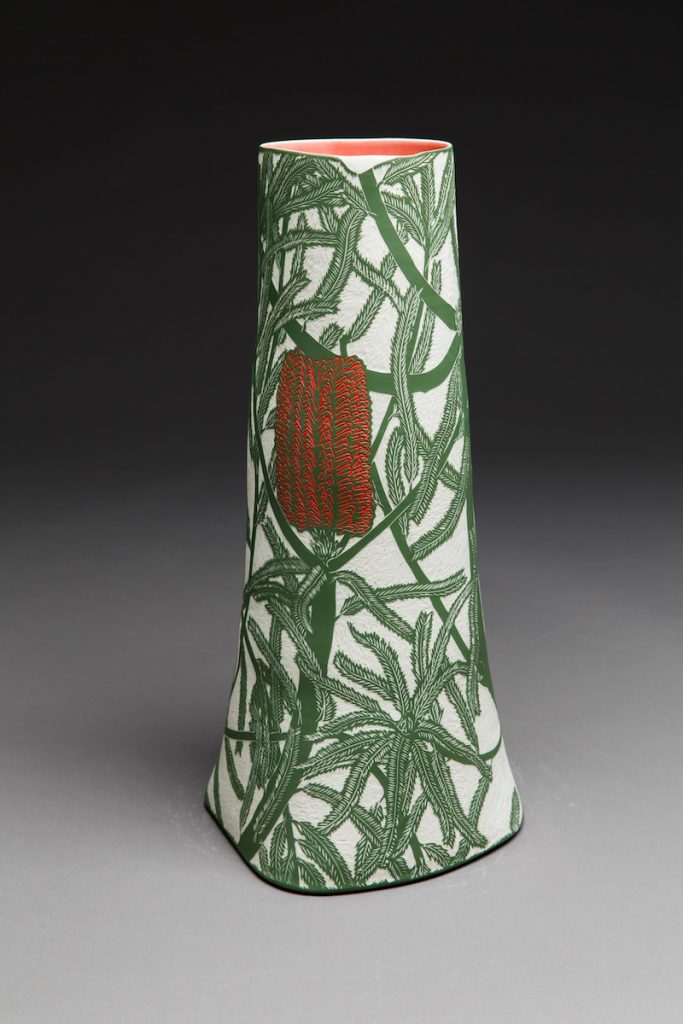
Banksia brownie, 2018, Porcelain, wheel-thrown and altered, sgraffito,
48.3h x 23.6w x 21.1d cm,
Photo by Andrew Sikorski-Art Atelier
Contact details:
Cathy Franzi
Website: www.cathyfranzi.com
‘Drawings’ Sabbia Gallery, 1 – 23 March 2019. https://sabbiagallery.com/exhibition/ceramic-masters-2019/
‘Coastal : Botanical’ Narek Galleries, 9 March – 27 April 2019. http://www.narekgalleries.com/future-exhibitions.html
Cathy Franzi, Canberra, Australia
Interview by Deborah Blakeley, February 2019
Think a colleague or friend could benefit from this interview?
Knowledge is one of the biggest assets in any business. So why not forward this on to your friends and colleagues so they too can start taking advantage of the insightful information the artist has given?
Other artists you may be interested in:


